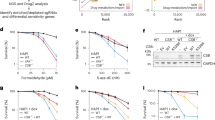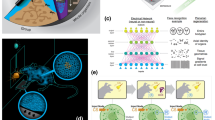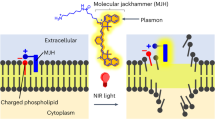Abstract
OXYGEN is known to enhance biological changes induced by ionising radiation1,2. The changes include chromosome breaks in Tradescantia3 mutation production in Drosophila, maize and bacteria3–6, and rate of mitosis in grasshopper neuroblasts7. The biological and physical bases for the various enhancements remain obscure, and it has not yet been established that they are the result of a common mechanism. The quantitative aspects of the relationship between oxygen concentration and radiation response have been measured: for example, killing of Escherichia coli by X-ray radiation at a constant radiation dose8 and various interpretations of the quantitative aspects of the response base have been made9–12. Ionising radiation has been proposed to interact with water to produce several products and these products interact with cellular material to produce the biological effects observed. In the reactions proposed, cellular sulphydryl groups are supposed to be a primary cellular constituent which is reactive with the radiation products from water. We report here that one major cellular sulphydryl constituent, glutathione (GSH), is apparently the major component in the interaction between radiation products and the cell, for cells unable to synthesise glutathione cannot be protected against killing by ionising radiation by reduction of the external oxygen concentration.
This is a preview of subscription content, access via your institution
Access options
Subscribe to this journal
Receive 51 print issues and online access
$199.00 per year
only $3.90 per issue
Buy this article
- Purchase on Springer Link
- Instant access to full article PDF
Prices may be subject to local taxes which are calculated during checkout
Similar content being viewed by others
References
Holthusen, H. Pflügers Archiv de gesante Physiologie 181, 1–25 (1921).
Kiefer, J. in Radiation Research: Biomedical, Chemical and Physical Perspectives, (ed. Nygaard, O. F.) 1025–1037 (Academic, New York, 1975).
Giles, N. H. & Riley, H. P. Proc. natn. Acad. Sci. U.S.A. 36, 336–344 (1950).
Baker, W. K. & Sgourakis, E. Proc. natn. Acad. Sci. U.S.A. 36, 176–184 (1950).
Schwartz, D. Proc. natn. Acad. Sci. U.S.A. 38, 490–494 (1952).
Hollaender, A., Baker, W. K. & Anderson, E. H. Cold Spring Harb. Symp. quant. Biol. 16, 315–326 (1951).
Gaulden, M. E. & Nix, M. Genetics 35, 665–666 (1950).
Hollaender, A. & Stapleton, G. E. Physiol. Rev. 33, 77–84 (1953).
Burnett, W. T., Stapleton, G. F., Morse, M. L. & Hollaender, A. Proc. Soc. exp. Biol. Med. 77, 636–638 (1951).
Burnett, W. T., Morse, M. L., Burke, A. W. & Hollaender, A. J. Bact. 63, 591–595 (1952).
Morse, M. L., Burke, A. W. & Burnett, W. T. J. Cell. comp. Physiol. 41, 407–417 (1953).
Alper, T. & Howard-Flanders, P. Nature 178, 978–979 (1956).
Fuchs, J. A. & Warner, H. R. J. Bact. 124, 140–148 (1975).
Apontoweil, P. & Berends, W. Biochim. biophys. Acta 399, 10–22 (1975).
Lowry, O. H., Rosebrough, N. J., Farr, A. L. & Randall, R. J. J. biol. Chcm. 193 265–275 (1951).
Bacq, Z. M. Experientia 7, 11–19 (1951).
Hollaender, A., Stapleton, G. E. & Burnett, W. T. in Use of Tracers in the Study of Biological Effects of Radiation 96–113 (CIBA Foundation, London, 1951).
Ashwood-Smith, M. J., Robinson, D. M., Barnes, J. H. & Bridges, B. A. Nature 216, 137–139 (1967).
Bridges, B. A. Adv. radiat. Biol. 3, 123–176 (1969).
Harris, J. W., Koch, C. J., Power, J. A. & Biaglow, J. E. Radiat. Res. 70, 585–596 (1977).
Bruce, A. K., Sansone, P. A. & MacVittie, T. J. Radiat. Res. 38, 95–108 (1969).
Author information
Authors and Affiliations
Rights and permissions
About this article
Cite this article
MORSE, M., DAHL, R. Cellular glutathione is a key to the oxygen effect in radiation damage. Nature 271, 660–662 (1978). https://doi.org/10.1038/271660a0
Received:
Accepted:
Issue Date:
DOI: https://doi.org/10.1038/271660a0
This article is cited by
-
Antiradical Properties of trans-2-(4-substituted-styryl)-thiophene
Journal of Fluorescence (2021)
-
Derivatives of natural amino acids as radioprotectors (review)
Pharmaceutical Chemistry Journal (1995)
Comments
By submitting a comment you agree to abide by our Terms and Community Guidelines. If you find something abusive or that does not comply with our terms or guidelines please flag it as inappropriate.



